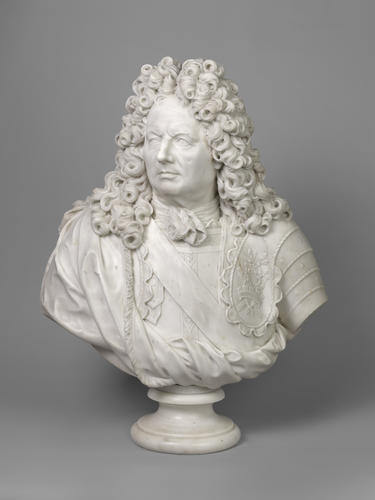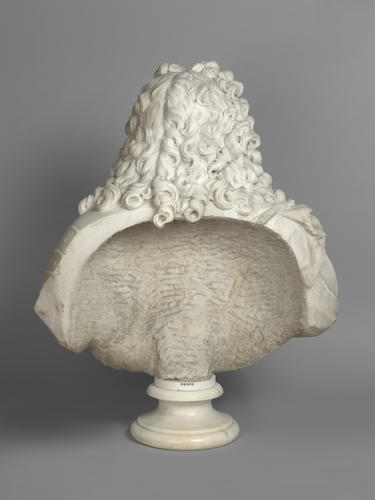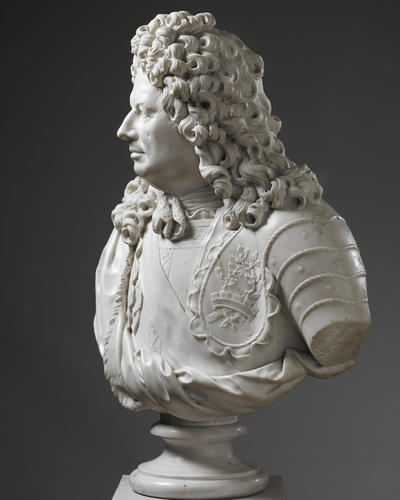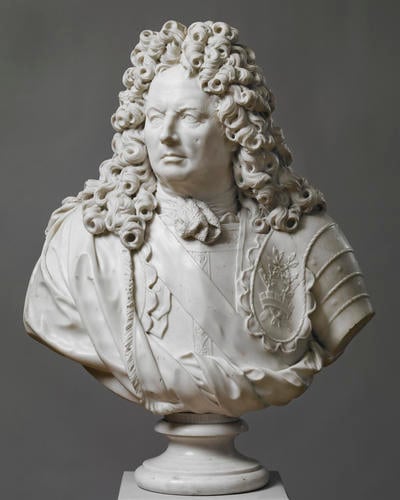-
1 of 253523 objects
Sébastien Le Prestre, Comte de Vauban (1633-1707) 1706
Marble | 72.0 x 68.0 x 24.0 cm (whole object) | RCIN 33305




-
A head and shoulder life-size marble bust of Sébastien Le Prestre, wearing armour and the order of the Saint-Esprit.
The head is slightly turned to the sitter’s right, and the pupils are fixed in the same direction. The full-bottomed wig, divided at the centre and composed of deeply drilled, tight curls, falls equally on both shoulders. The high, receding forehead is slightly creased, and sharply so at the top of the nose, from which point the eyebrows slant steeply upwards in a frown. The pupils are incised and the irises indicated. There is a round dent in the otherwise fleshy cheek below the sitter’s left eye. A lace cravat is tied at the throat. The ribbon of the order of Saint-Esprit is worn from the sitter’s right shoulder. A fringed cloak is thrown over the right shoulder and twisted along the front truncation. On the front of the sitter’s left shoulder-piece a device is carved in low relief: a crenellated turret pierced by a sprig of laurel and another of oak foliage, crossed at top and bottom in an ellipse against two crossed batons. Incised along the front truncation, on the right: COYZEVOX.F./ 1706; on the truncation of the sitter’s left arm: QUAE NON MAENIA. The curls of the wig slightly overlap the back truncation. The hollow back is roughly punched out, with the number 18 incised in the centre, and below that the Windsor inventory number 91 alongside a crown. On an attached, turned-and-waisted socle with an inserted marble disc incised at the front: SEBASTIAN LE PRESTRE, MARSHAL VAUBAN.
The pre-eminent sculptor in marble in the second half of the reign of Louis XIV, Antoine Coysevox was the son of a joiner (maître-menuisier), Pierre Coysevox. He moved to Paris in 1657 and worked in the studios of various sculptors including Louis Lerambert as well as studying at the Académie des Beaux-Arts. His marriage to Marguérite Quillerier followed a dependable pattern for aspiring artists: she was Lerambert’s niece, and the daughter of Noel Quillerier, peintre and valet de chambre du Roi. From 1666 Coysevox was himself styled Sculpteur du Roi. From 1679 until 1688 he was engaged on the architectural decoration of the State Apartments and gardens at Versailles, where he set up a studio. In 1684 he was living at the Gobelins, and he was granted an apartment at the Louvre in 1698.
The sitter, the Maréchal de Vauban, is best remembered as the supreme exponent of the art of building and undermining fortifications. He was also an architect, a statistician and an expert on soil improvement. Born of poor parents who died when he was ten, he was entirely self-made. Despite his place in the French military pantheon, portraits from Vauban’s lifetime are rare. The circumstances of the sittings for this unique and superb bust are unknown, but Coysevox has faithfully recorded the permanent scar on the Marshal’s cheek, caused by a ‘flash in the pan’ from a musket, a particular hazard for a left-handed shot. The soft handling of the face is characteristic of Coysevox’s last portraits, where the grand manner gives way to a more personal characterisation. The strongly turned head and apparently distantly focused eyes impart the sense of a 'man of destiny'.
The blazon on the Marshal’s shoulder-piece has eluded identification and may be a plausible piece of invention on the part of Coysevox, while the Latin motto can be translated as ‘No such walls,’ suggesting either that there were no fortifications that Vauban could not undermine, or that no walls as strong as his had ever been made (or perhaps both). The socle is a replacement of the type supplied for the Grand Corridor by W. and C. Adron in 1830.
Text adapted from Sculpture in the Collection of His Majesty The King (2025)
Provenance
Purchased by George IV in the Watson-Taylor auction, Christie's, 28 May 1825 for £106.1s.2d (Lot 62). Received at Carlton House and snt to St James's Palace store. Sent to Windsor Castle on 12 November 1828 and subsequently placed in the Grand Corridor. Recorded in the Presence Chamber at Windsor Castle in 1905.
-
Creator(s)
Acquirer(s)
-
Medium and techniques
Marble
Measurements
72.0 x 68.0 x 24.0 cm (whole object)
Category
Object type(s)
Place of Production
France